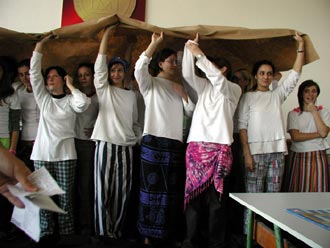|
Shkart-biography
From "the
smallest town in the city" - Huma (17 villagers), to the flea
market in Panchevo, Horkeshkart have participated (and still are) in
spaces outside the privileged culture-markets (villages, schools,
refugee camps) and also on art happenings (Opening of the
Contemporary art museum in Belgrade, Cetinje Bienalle, presentation
in Gratz, Osaka, Brehmen), |
|
 The
art group Shkart, formed 1990 in Belgrade is one of the most
significant artistic groups that comes from the ex-Yugoslavia, which
gain great international success. Focused mainly on the
lyrical-subversive treatment on the immediate reality and on
everyday life and they create a kind of "recycled" works
which correspond with the most recent trends in the socially
orientated art. Until now they have exhibited in more than 30 towns
around the world, and is one of the rare from the region in the
respected museum MOMA in New York. They have participated in
Manifesta and worked and exhibited in America, Europe and Japan.
Their art works are published in many important magazines for visual
art like Print, Interview, where Andy Warholl have published. They
have been grafic designers to many publications for B92 and the
magazine Rech. The
art group Shkart, formed 1990 in Belgrade is one of the most
significant artistic groups that comes from the ex-Yugoslavia, which
gain great international success. Focused mainly on the
lyrical-subversive treatment on the immediate reality and on
everyday life and they create a kind of "recycled" works
which correspond with the most recent trends in the socially
orientated art. Until now they have exhibited in more than 30 towns
around the world, and is one of the rare from the region in the
respected museum MOMA in New York. They have participated in
Manifesta and worked and exhibited in America, Europe and Japan.
Their art works are published in many important magazines for visual
art like Print, Interview, where Andy Warholl have published. They
have been grafic designers to many publications for B92 and the
magazine Rech.
Horkeshkart question the values of the cultural heritage breaking
through the local-traditionalism and mixing the optimism from the
socialist era of rebuilding the country (from the 1950s and 1960s)
with a lyrical note of the cant-authors (A. Dedic, D. Radovic, Z.
Brasans...), the energy of the liberating new wave (V. Divljan) and
the inventiveness of all the "new waves" (Jarboli,
Chinch).
From "the smallest town in the city" - Huma (17
villagers), to the flea market in Panchevo, Horkeshkart have
participated (and still are) in spaces outside the privileged
culture-markets (villages, schools, refugee camps) and also on art
happenings (Opening of the Contemporary art museum in Belgrade,
Cetinje Bienalle, presentation in Gratz, Osaka, Brehmen), washing
out the prejudices for the "place" of the chorus music in
the contemporary art and in the new-old forms of colective.
|
|
|
|
|
|
|

|